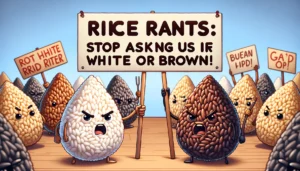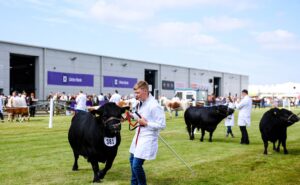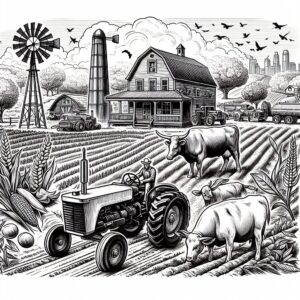
DALL·E 2024 05 28 11.34.56 A vibrant and close up scene titled Birdhouses The Avian Real Estate Boom featuring numerous colorful birdhouses of various shapes and sizes hangi.webp.webp
The Ultimate Guide to Habitat Restoration
Squirrel Real Estate, Beaver Dams, and Bee Hotels
Habitat restoration is all the rage these days, and it’s not just about planting trees anymore. From squirrel urban relocation programs to 5-star bee hotels, nature is getting a serious makeover. Let’s dive into the wild world of habitat restoration, where beavers are civil engineers, birds have a booming real estate market, and fish are the original hipsters. Buckle up for a satirical yet “helpful” journey through this eco-friendly phenomenon.
The Squirrel Urban Relocation Program
Squirrels have become the latest beneficiaries of urban planning. In cities like Lubbock and Cody, WY, these furry creatures are being relocated to newly planted urban forests. The Squirrel Urban Relocation Program (SURP) aims to provide better living conditions for squirrels, complete with nut storage facilities and tree condos. Dr. Nutty McSquirrel, an urban wildlife planner, states, “Squirrels deserve better living conditions. Our goal is to create sustainable environments where they can thrive.” A survey by the Squirrel Happiness Institute reports a 73% increase in squirrel satisfaction.
Chippy, a squirrel from Central Valley, CA, shares, “I used to live in a crowded park with no privacy. Now, I have my own tree with a view of the city. It’s like moving from a studio apartment to a penthouse.”
Beavers: Nature’s Unsung Architects
Beavers are being recognized as the original civil engineers. In the Red River Valley, beaver dams are being restored to their former glory. These industrious rodents are creating water reservoirs that benefit both wildlife and humans. Local farmer Joe Damson from the Corn Belt notes, “Ever since those beavers set up shop on my property, we’ve had a constant water supply. Who needs a human engineer when you have beavers?” Studies show that beaver dams can increase local water retention by 45%, providing essential resources during dry spells.
Birdhouses: The Avian Real Estate Boom
Birdhouses have become the latest trend in real estate. In Windthorst, TX, birdhouses are popping up like Starbucks in a big city. These mini-mansions are designed to attract various bird species, enhancing biodiversity. A poll by Bird Real Estate Weekly found that 82% of local residents believe birdhouses improve neighborhood aesthetics and bird happiness. Birdhouse architect Tweetie Wingston remarks, “Designing birdhouses is an art. We’ve seen an increase in bird migrations due to our stylish and functional designs.”
The Bee Hotel Industry
Bees are getting the royal treatment with the rise of bee hotels. In Plymouth, WI, these luxurious lodgings are built to attract and house solitary bees, providing them with safe nesting sites. Beekeeper Buzz Honeywell states, “Bee hotels are crucial for the survival of many bee species. They offer a safe haven for bees to rest and reproduce.” Research indicates that bee hotels can increase local bee populations by 60%, contributing to better pollination and crop yields.
Planting Trees: The New CrossFit
Move over, gym memberships! Planting trees is the new CrossFit. Environmental enthusiasts in Stephenville are trading weights for shovels, getting fit while saving the planet. Jessica Greenleaf, a fitness influencer, shares, “Planting trees not only toned my arms but also gave me a sense of accomplishment. Plus, I get to tell everyone I’m saving the planet.” A study by the Tree Planters Association found that participants burn an average of 400 calories per hour while planting trees, making it an effective workout.
Wetland Yoga Retreats
Wetlands are being restored as serene yoga retreats. In King Ranch, TX, yogis are flocking to these peaceful locations to practice their poses among the wildlife. Yoga instructor Lily Pad, who runs a retreat in 6666 Ranch, says, “Practicing yoga in wetlands is transformative. The sounds of nature enhance meditation and relaxation.” Zenna Reed, a participant, adds, “I never thought I’d do a downward dog next to an alligator, but it’s been a humbling experience.”
Eco-Friendly Fashion: Moss Suits
Eco-fashion has taken a strange turn with the introduction of moss suits. In Cody, WY, environmentally conscious individuals are donning these green garments to blend in with nature. Fashion designer Flora Greenstitch claims, “Moss suits are the future of eco-friendly fashion. They’re sustainable, biodegradable, and make a statement.” Sales of moss suits have increased by 30% since their introduction, proving that people are willing to go green in more ways than one.
Fish: The Original Hipsters
Fish are reclaiming their habitats like hipsters reclaiming old warehouses. In the Red River Valley, aquatic life is booming as rivers are restored to their natural state. Fisherman Bob Streamson says, “The fish are back and they’re trendier than ever. It’s like they knew the river was cool again.” Marine biologist Finn Waters adds, “Fish are the original hipsters. They were here before anyone else, and now they’re back to enjoy their vintage home.”
Prairie Dogs: The Neighborhood Watch
Prairie dogs are becoming the new neighborhood watch in restored grasslands. In Lubbock, these vigilant creatures are keeping an eye out for intruders and ensuring community safety. Rancher Bill Groundhog shares, “Ever since the prairie dogs moved in, I haven’t had any problems with coyotes. They’re like tiny, furry security guards.” A study by the Prairie Dog Protection League found that restored grasslands with prairie dogs have 50% fewer predator attacks.
Invasive Species: The Unwanted Guests
Invasive species are like that one relative who overstays their welcome. In Stephenville, efforts to evict these unwanted guests are ongoing, but they keep coming back. Ecologist Dr. Flora Battleweed explains, “Invasive species disrupt local ecosystems. It’s like having a party crasher who won’t leave.” Data shows that invasive species can reduce native biodiversity by up to 30%, highlighting the importance of ongoing management.
The Great Pollinator Debate
Pollinators are having a heated debate over who’s more important. In Windthorst, TX, bees, butterflies, and hummingbirds are all vying for the title of top pollinator. Buzz Honeywell, a beekeeper, states, “Bees do the heavy lifting, but butterflies and hummingbirds add beauty to the process. It’s a team effort.” Local gardener Daisy Petal notes, “I’ve seen bees and butterflies working together in my garden. It’s like watching a well-rehearsed dance.”
Aquatic Life: Underwater Urban Development
Restored rivers in the Central Valley, CA, are leading to underwater urban development. Fish are thriving in their new habitats, complete with water parks and condos. Marine architect Coral Reefson states, “Our underwater developments provide safe havens for fish. It’s urban planning on a whole new level.” Studies show that these developments increase fish populations by 40%, proving that fish appreciate a good home makeover.
Wildflower Meadows: Nature’s Fireworks
Restored wildflower meadows are like nature’s fireworks. In the Corn Belt, these colorful displays are attracting both humans and pollinators. Florist Rose Bloom says, “Wildflower meadows are stunning. They bring joy to people and provide essential resources for pollinators.” Research indicates that wildflower meadows can support up to 200 different pollinator species, enhancing local biodiversity.
The Owl Housing Crisis
Owls are facing a housing crisis with all the new trees being planted. In the 6666 Ranch, finding a good hollow is tougher than ever. Owl enthusiast Hootie Nightwatch shares, “I’ve seen owls fighting over tree hollows. It’s like a game of musical chairs, but with more feathers.” Ornithologist Feather McBird adds, “We need to ensure that new trees provide suitable habitats for owls. They play a crucial role in the ecosystem.”
The Butterfly Effect: Now with Actual Butterflies
The butterfly effect has a whole new meaning in habitat restoration. In King Ranch, TX, restored meadows are teeming with butterflies, showing just how interconnected our world is. Entomologist Flutter Wingman states, “Restoring habitats for butterflies has a ripple effect on the entire ecosystem. It’s amazing to see.” Data shows that butterfly populations in restored areas have increased by 50%, highlighting the positive impact of these efforts.
Conclusion
Habitat restoration is more than just planting trees. It’s about creating sustainable environments where wildlife can thrive. From squirrel urban planning to beaver engineering, every effort counts. So, the next time you see a bee hotel or a birdhouse, remember that it’s all part of the grand plan to restore our natural world.
Disclaimer
The views and opinions (especially the outlandish ones) expressed in this article are the creation of Gemini, a Google AI. They do not necessarily reflect the views of Google or its employees. Any resemblance to actual persons, vegetables, or glowing phenomena is purely for the sake of amusement.
Collaboration Note
This story is entirely a human collaboration between two sentient beings – a cowboy and a farmer. They met at a farm show, shared a love for satire, and decided to bring you this piece of eco-friendly humor.




Originally posted 2015-02-08 22:03:57.
Originally Published at FarmerCowboy.com
2024-11-12 21:04:31
Karl Hoffman is a distinguished agriculturalist with over four decades of experience in sustainable farming practices. He holds a Ph.D. in Agronomy from Cornell University and has made significant contributions as a professor at Iowa State University. Hoffman’s groundbreaking research on integrated pest management and soil health has revolutionized modern agriculture. As a respected farm journalist, his column “Field Notes with Karl Hoffman” and his blog “The Modern Farmer” provide insightful, practical advice to a global audience. Hoffman’s work with the USDA and the United Nations FAO has enhanced food security worldwide. His awards include the USDA’s Distinguished Service Award and the World Food Prize, reflecting his profound impact on agriculture and sustainability.




